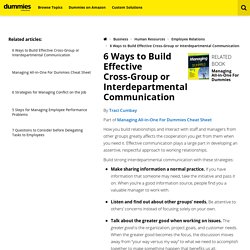

Best Strategies: Interdepartmental Communication [Case Study] In the 2004 Olympics, the American men’s relay team shocked the crowd for all the wrong reasons.
![Best Strategies: Interdepartmental Communication [Case Study]](http://cdn.pearltrees.com/s/pic/th/interdepartmental-227193946)
With an average 100-meter sprint time of 9.89 seconds each, they were one of the fastest relay teams ever. Everyone thought they were a sure bet to win gold that year. But they didn’t. The team individually were so confident in their speed that they only ever practiced handing-off the baton together twice. A fumble during the race meant that the slower British men’s team, who at that point had not won a single medal at that Olympics, pulled ahead and beat them by only one hundredth of a second. How? Teamwork. The athletes in the British team had suffered baton fumbles before in the 1996 Olympics and 1999 World Championships. Part 1 Why Interdepartmental Communication matters There are two types of internal communication: intradepartmental (within the same department) and interdepartmental (between two different departments).
Part 2. ADP BrandVoice: 3 Strategies For Better Interdepartmental Communication. By Bill Cushard To get meaningful work done in organizations, effective interdepartmental communication is a must.

In a study on change and communication ROI, Towers Watson concluded that "companies with high effectiveness in change management and communications are three and a half times more likely to significantly outperform their industry peers than firms that are not effective in these areas. " Most of us have experienced both effective and ineffective interdepartmental communications and understand how much better we as individuals and our teams perform when we communicate effectively. The CHRO can play a vital role in removing barriers and putting processes in place to help teams accomplish departmental goals while at the same time achieve overarching organizational strategies. Here are three strategies for improving interdepartmental communication: 1. 14 ways to improve interdepartmental communication. The Young Entrepreneur Council is an invite-only organization composed of the world’s most promising young entrepreneurs.

YEC has also launched BusinessCollective, a free virtual mentorship program that helps millions of entrepreneurs start and grow businesses. Read previous SmartBrief posts by YEC. If you enjoy this article, sign up for SmartBrief’s free e-mails for entrepreneurs. 1. Avoid silos Our team started developing silos at eight people. 6 Ways to Build Effective Cross-Group or Interdepartmental Communication. By Traci Cumbay Part of Managing All-in-One For Dummies Cheat Sheet How you build relationships and interact with staff and managers from other groups greatly affects the cooperation you get from them when you need it.

How to Build Workplace Relationships with Other Departments. Doing that isn’t just about building personal relationships – although that certainly helps – but about paying attention to the way you work with other departments and the signals you send when you need their assistance.

Specifically… 1. Pay attention to how they prefer to communicate. You don’t have to totally subsume your own communication style to another department’s just to build good relationships, but it’s worth paying attention to how they seem to prefer to communicate and factoring that into your own approach. If, for instance, your IT department has a ticketing system for new issues, they’re not going to be fond of the person who always walks over to report a problem. 2. 3. 4. 11 Ways to Improve Collaboration Between Departments. Ling Wong, Dec 4, 2019 How is your team “getting along” with other departments in your company?

If your answer is a shrug and a “we do ok,” you’re probably not maximizing your team’s productivity and results by building synergistic relationships with other departments. Collaboration between departments is more than simply “cooperating” with other teams. It involves a shared vision, mutual respect, and in-depth understanding of each other’s role in a project with the goal of achieving excellent business outcomes and outstanding customer experience. Consider this scenario: A large insurance company developed a new suite of products to meet unique customer needs. Or this example: A global manufacturing firm wanted to customize a product component for one of its major customers. These are very real situations that could happen in any company of any size in any industry.
Stop asking 'how are you?' Harvard researchers say this is how successful people make small talk. “How are you?”

These are the three most useless words in the world of communication. The person asking doesn’t really want to know, and the person responding doesn’t tell the truth. What follows is a lost opportunity and meaningless exchange with zero connection. But the key to making the most out of small talk, according to Harvard researchers, is to simply ask the other person follow-up questions. In a series of experiments, researchers analyzed more than 300 online conversations and found that those who were asked more meaningful follow-up questions (a.k.a. questions that aren’t “how are you?” “When people are instructed to ask more questions, they are perceived as higher in responsiveness, an interpersonal construct that captures listening, understanding, validation and care,” the researchers wrote. Frances Frei: How to build (and rebuild) trust. Video- John C Maxwell - How To Connect With People.